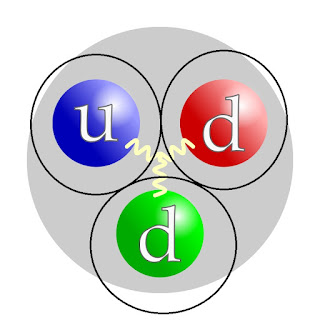Above this text is an image of neutron (Image 1). The effect of the strong interaction strong nuclear force marked as a "Y"-shaped structure. But what is the thing that makes those quarks stay in one entirety? The 2 down quarks and 1 up quarks. Along with gluons, those quarks form neutrons. 2 Up quarks and 1 down quark with gluons form protons. The gluons connecting those particles to their entirety are called neutrons or protons.
The strong interaction is not the interaction between quarks. It is the interaction between quarks and gluons. But why gluons are keeping the neutrons and protons as one entirety. There is the possibility that the gluon is orbiting quarks by the eight-shaped trajectory. And that thing means that the pressure of that particle is pushing the quarks to one entirety. Those trajectories are drawn in image 2 by using black circles. (Image 2)
When we are thinking about image 2. There are marked possible trajectories of gluons. The trajectories could be "8"-shaped. But gluons can also orbit those quarks with regular orbiting trajectories. That causes an idea that could there be the forms that we can call "atoms in atoms". So could some elementary particle be the "miniature atom"?
Why do I think like this? The reason for that is that. If the gluons are moving or jumping between those quarks. That could destroy the proton or neuron. So there must be some kind of electromagnetic vacuum in the middle of those quarks. Or the gluons would orbit around those quarks that cause their quantum fields are pushing quarks together.
Image 2:
Explanation 2.
Could the mysterious graviton be the particle in the middle of the proton or neutron? The theory is that graviton could just be the quantum-size black hole.
About the question of why protons and neutrons are in their form? In that case. The quantum-size black hole or hypothetical graviton pulls superstrings from quarks inside it. That thing causes the radiation that is called dark energy and the expansion of the universe.
But that requires that graviton exists. The hypothetical quantum-size black holes are acting just like large black holes. When they are pulling something inside them. That thing causes radiation. So could the graviton be the quantum-size black hole?
But there can be some other interesting explanation for that thing. And that thing is the most fascinating in the world. Maybe there is graviton in the middle of protons or neutrons. That thing means that the graviton could be a quantum-size black hole. That pulls the strings from the quarks inside it.
Because energy or superstrings are traveling only in one direction. That is in the middle of the quarks that cause the recoil effect. The recoil effect keeps those quarks at a certain distance from the center of the particle. And the balance between the pushing and pulling effect keeps those quarks in one entirety.
But if quarks are like small yarn balls they are losing their mass all the time when that quantum-size black hole will pull those superstrings in it. And that causes the radiation.
https://en.wikipedia.org/wiki/Gluon
https://en.wikipedia.org/wiki/Graviton
https://en.wikipedia.org/wiki/Neutron
https://en.wikipedia.org/wiki/Proton
https://en.wikipedia.org/wiki/Quark
https://en.wikipedia.org/wiki/Standard_Model
https://en.wikipedia.org/wiki/Strong_interaction
https://thoughtsaboutsuperpositions.blogspot.com/






No comments:
Post a Comment
Note: Only a member of this blog may post a comment.